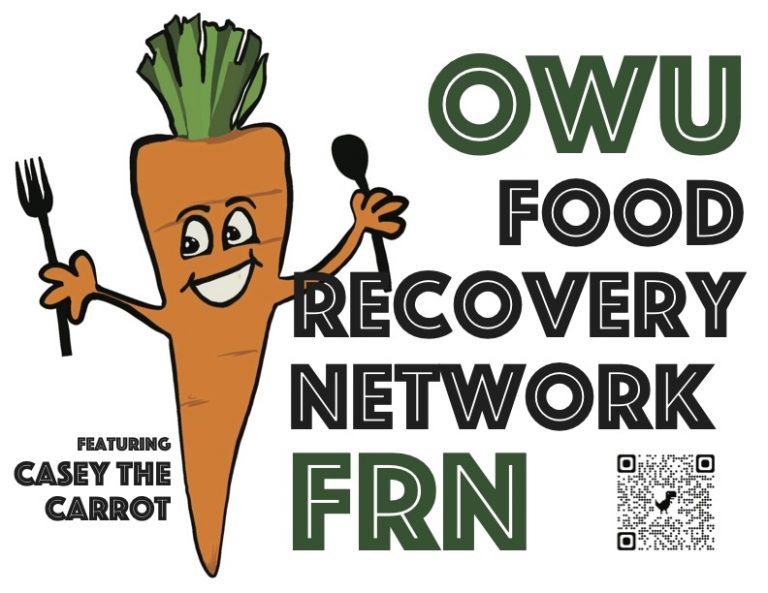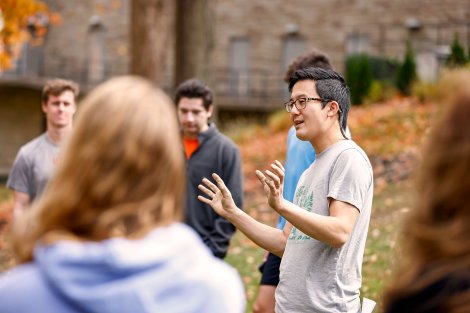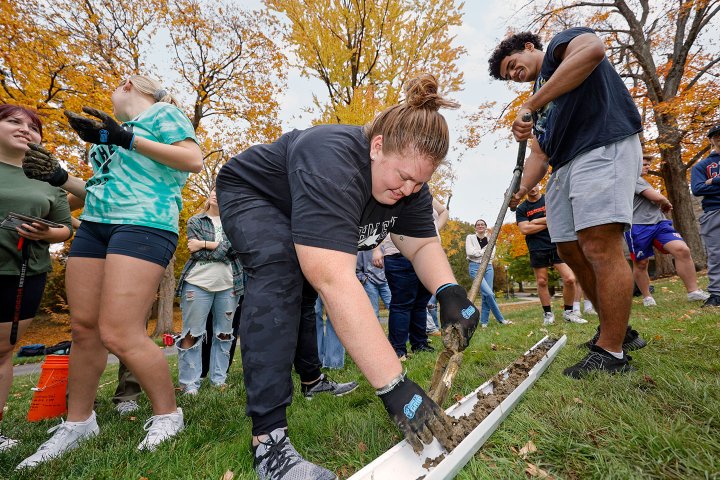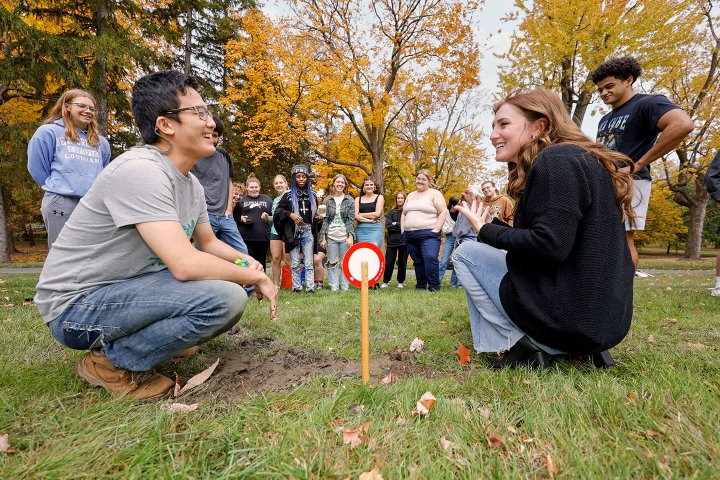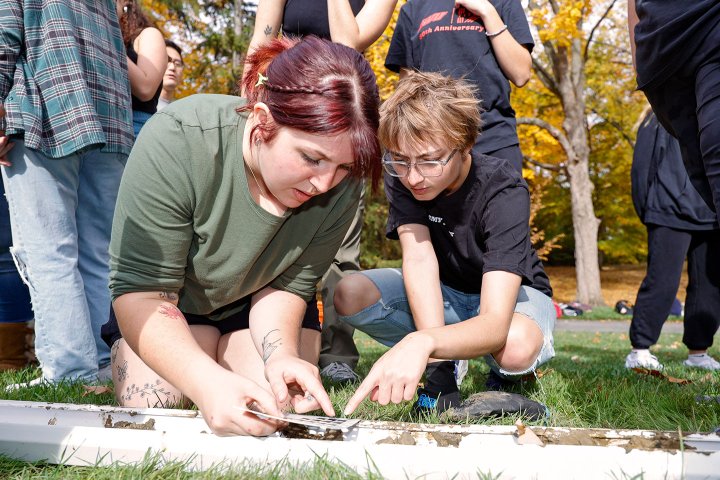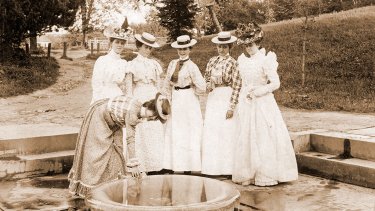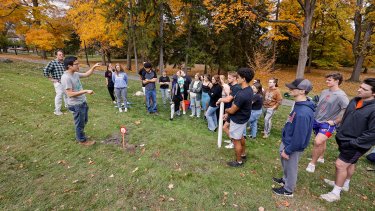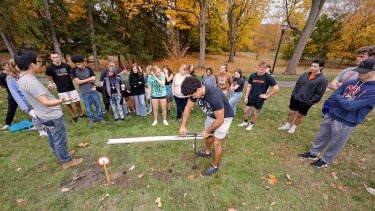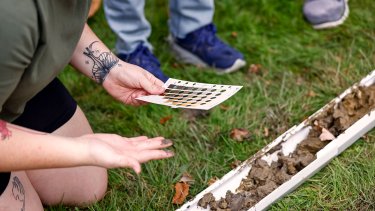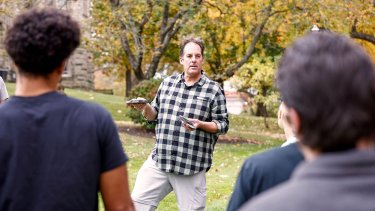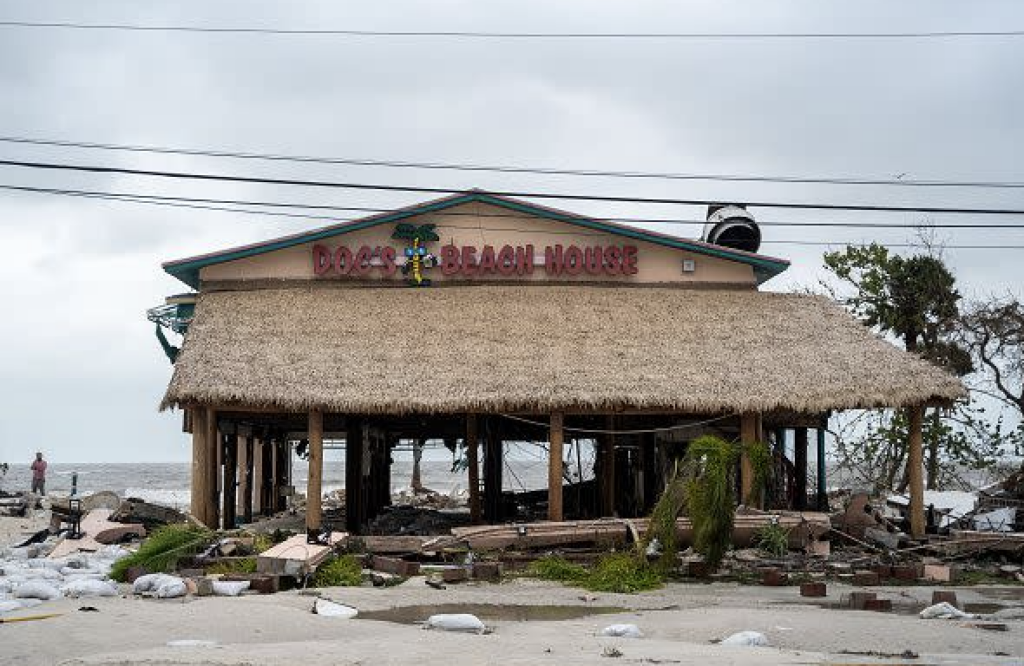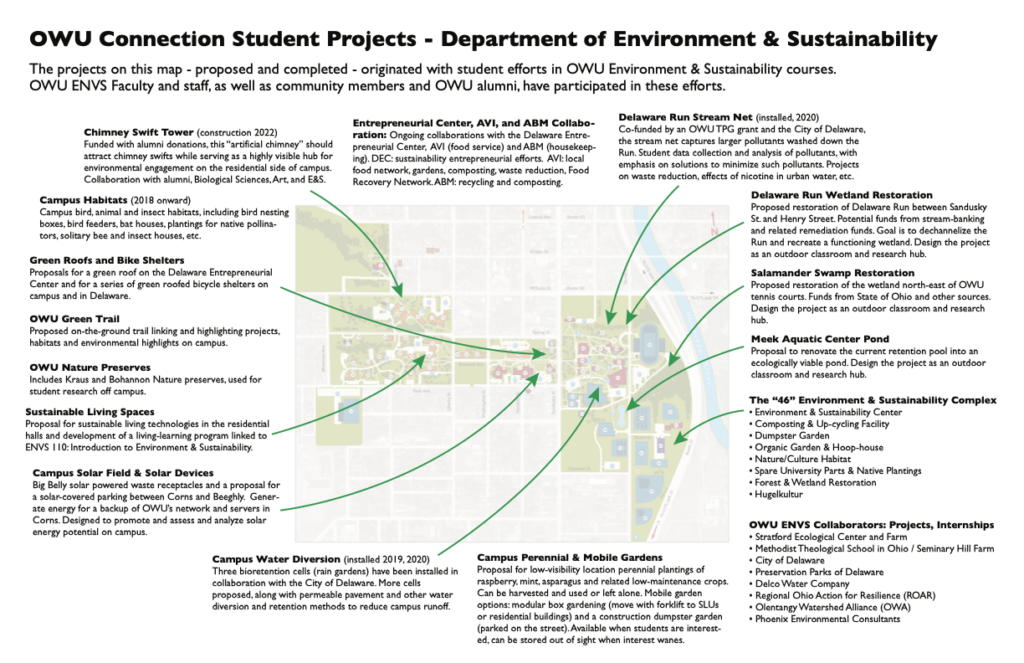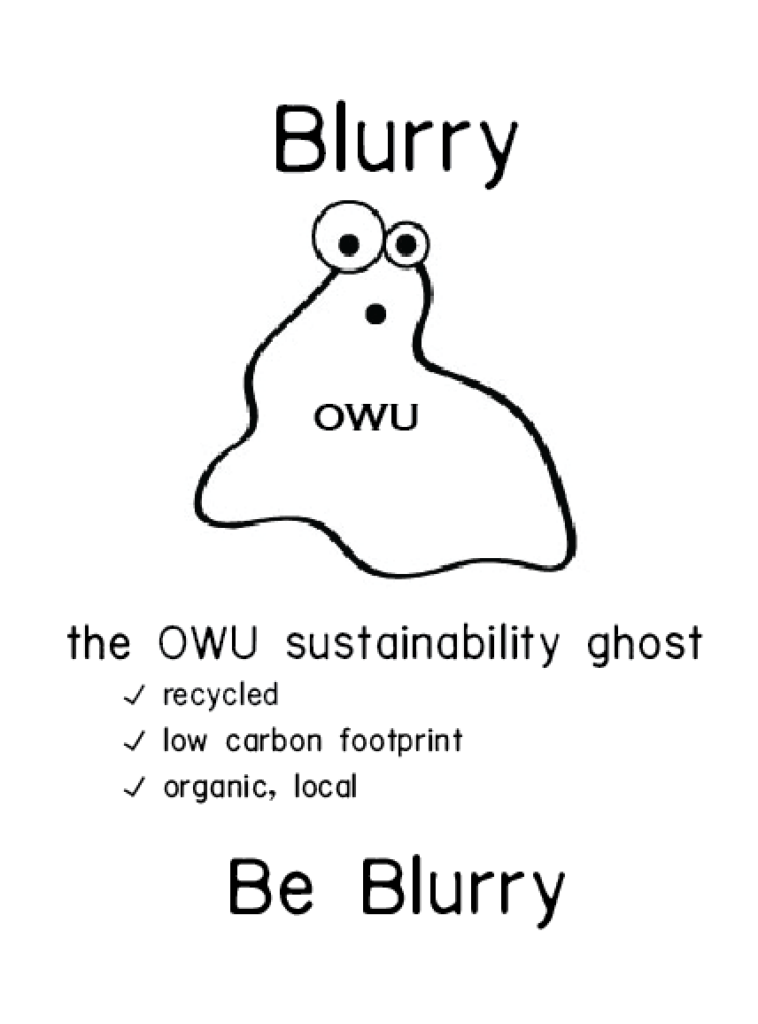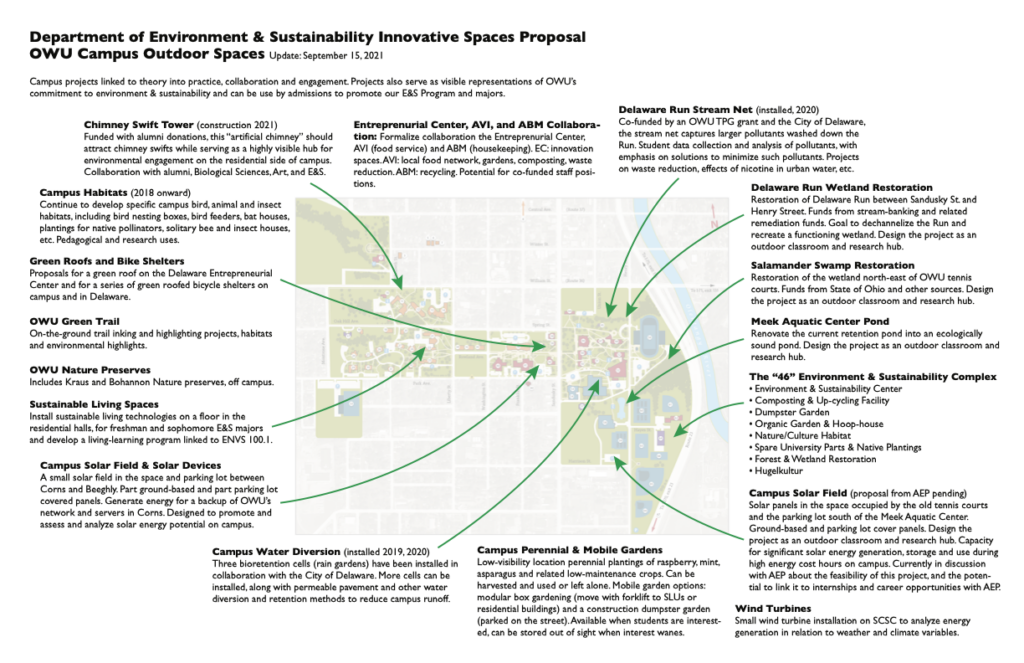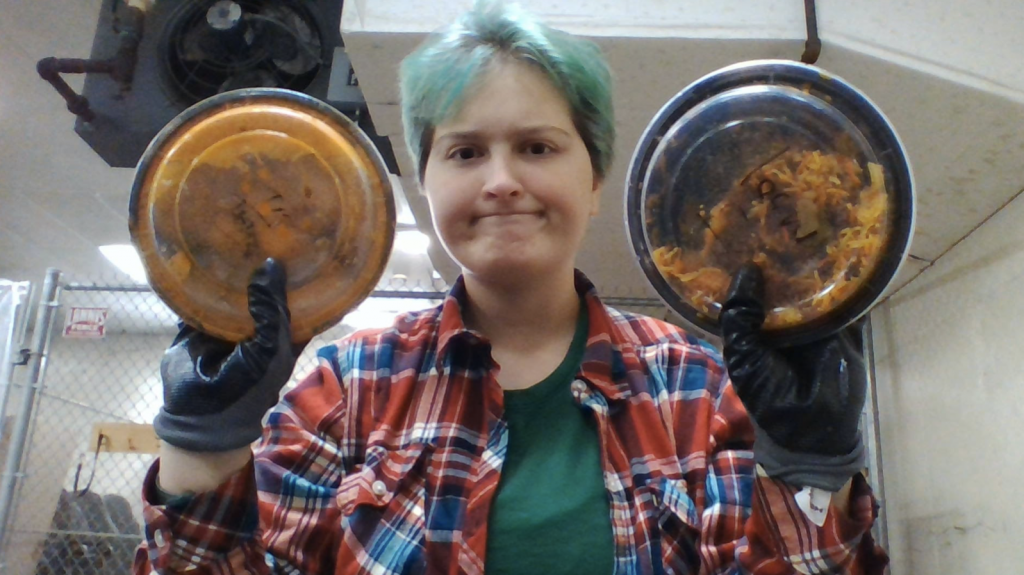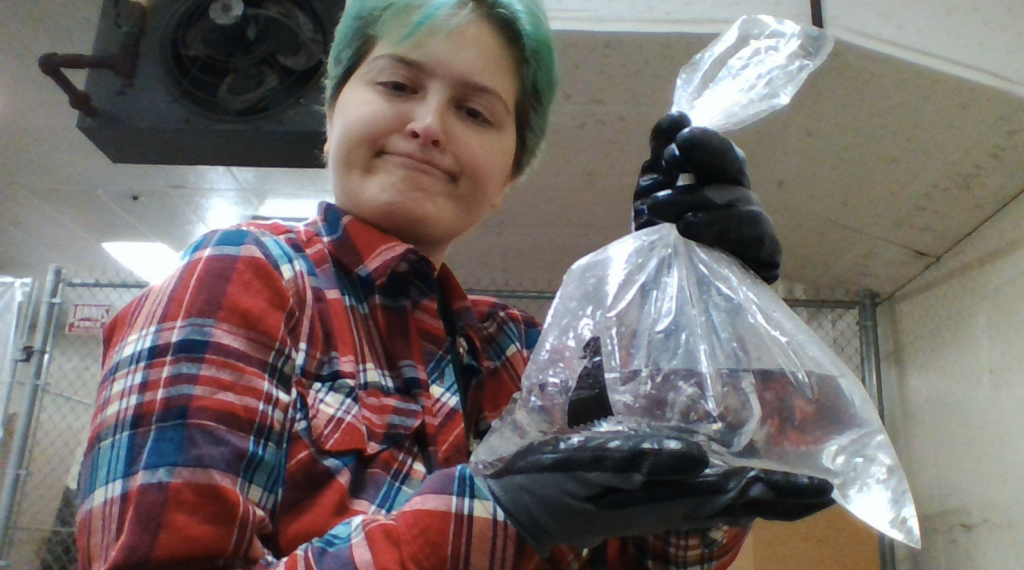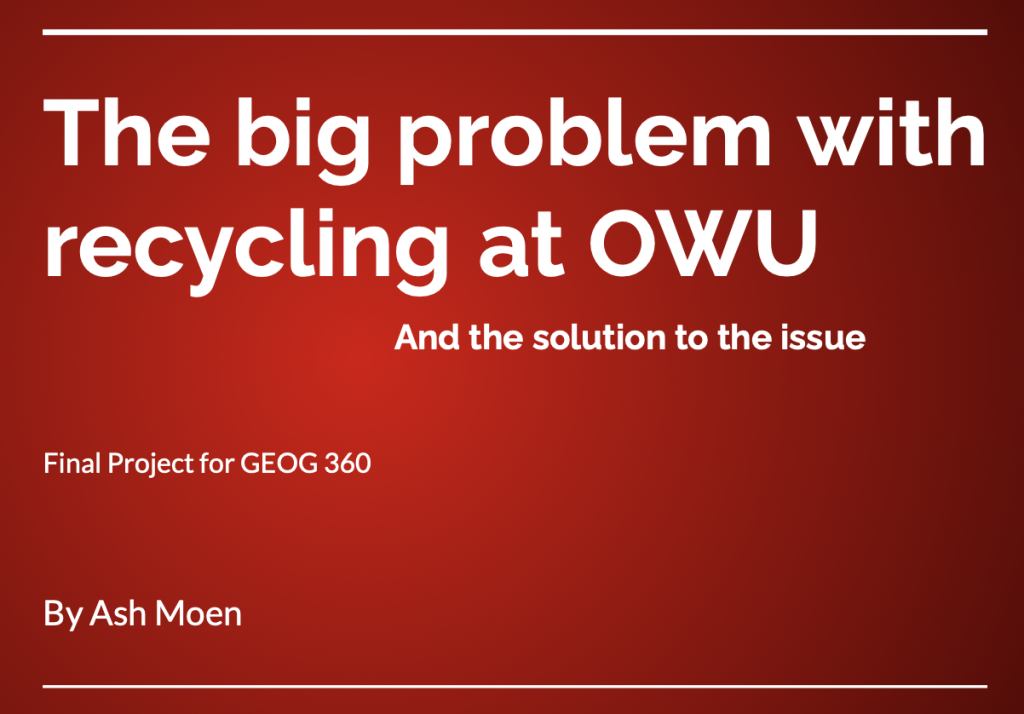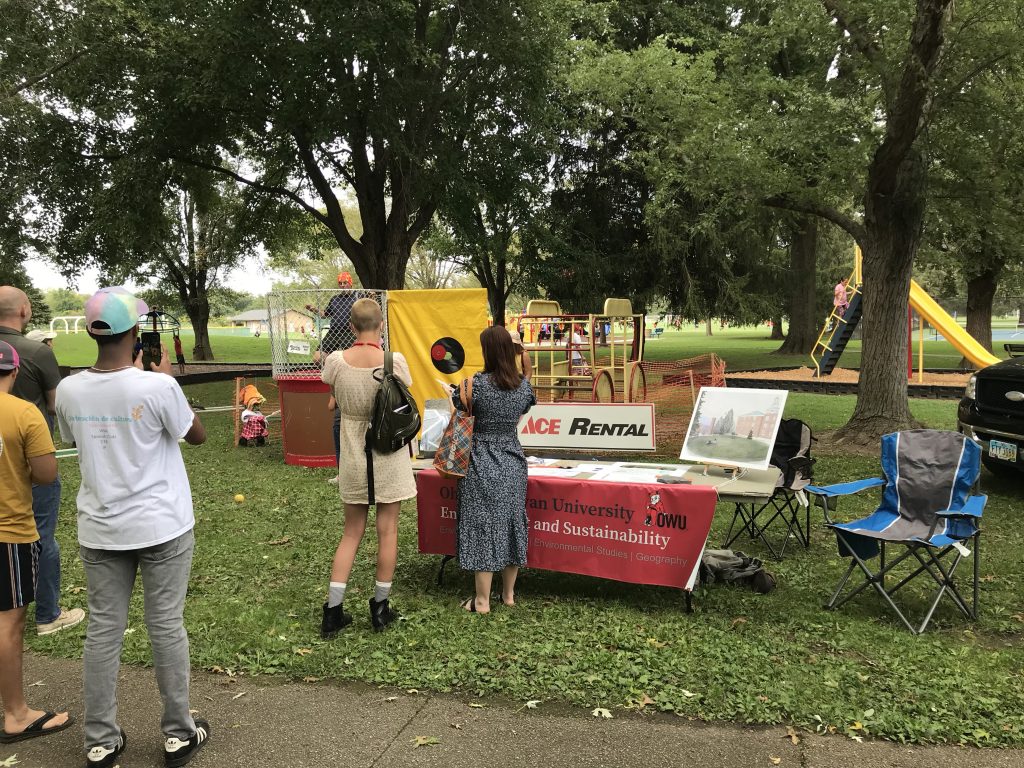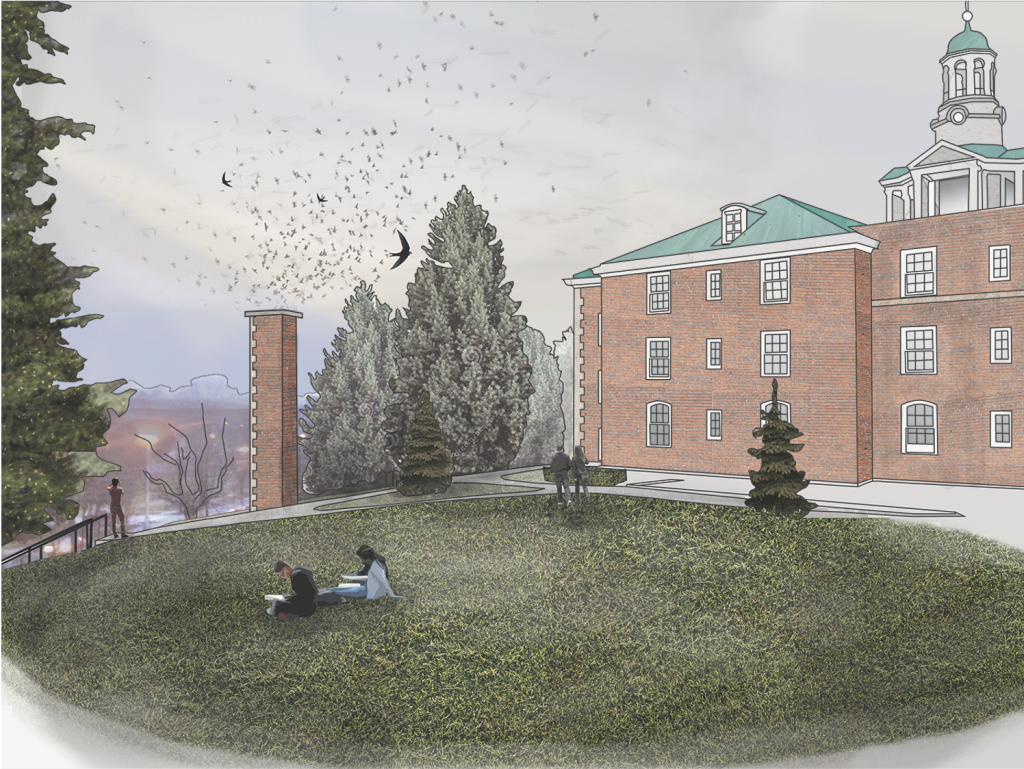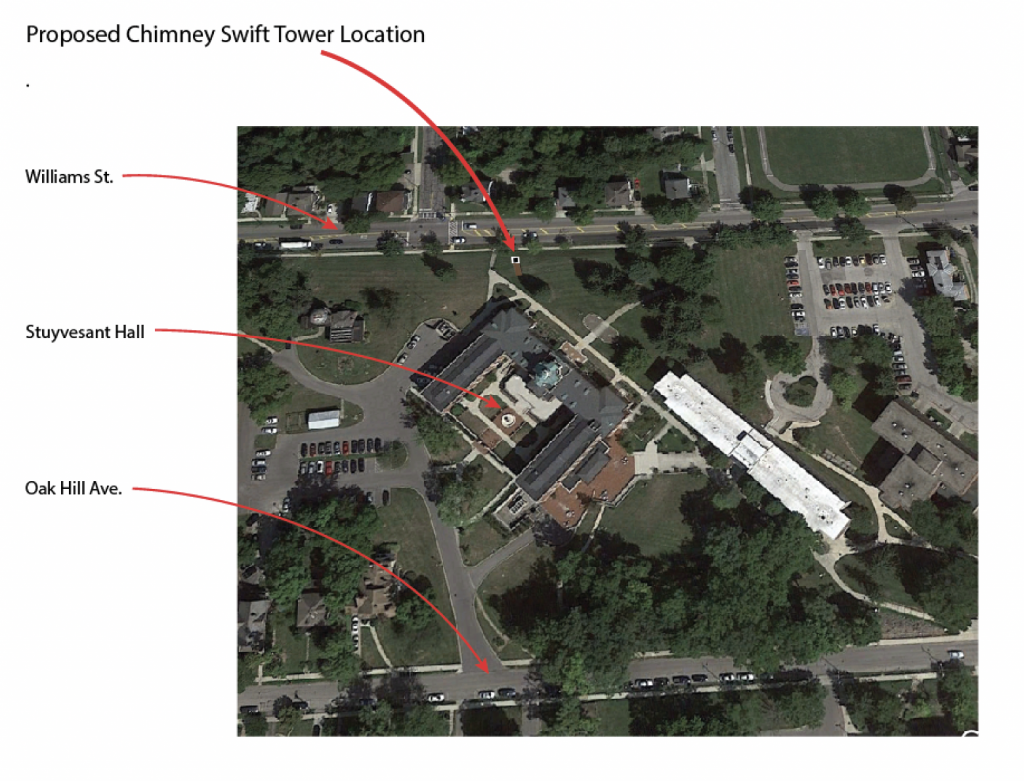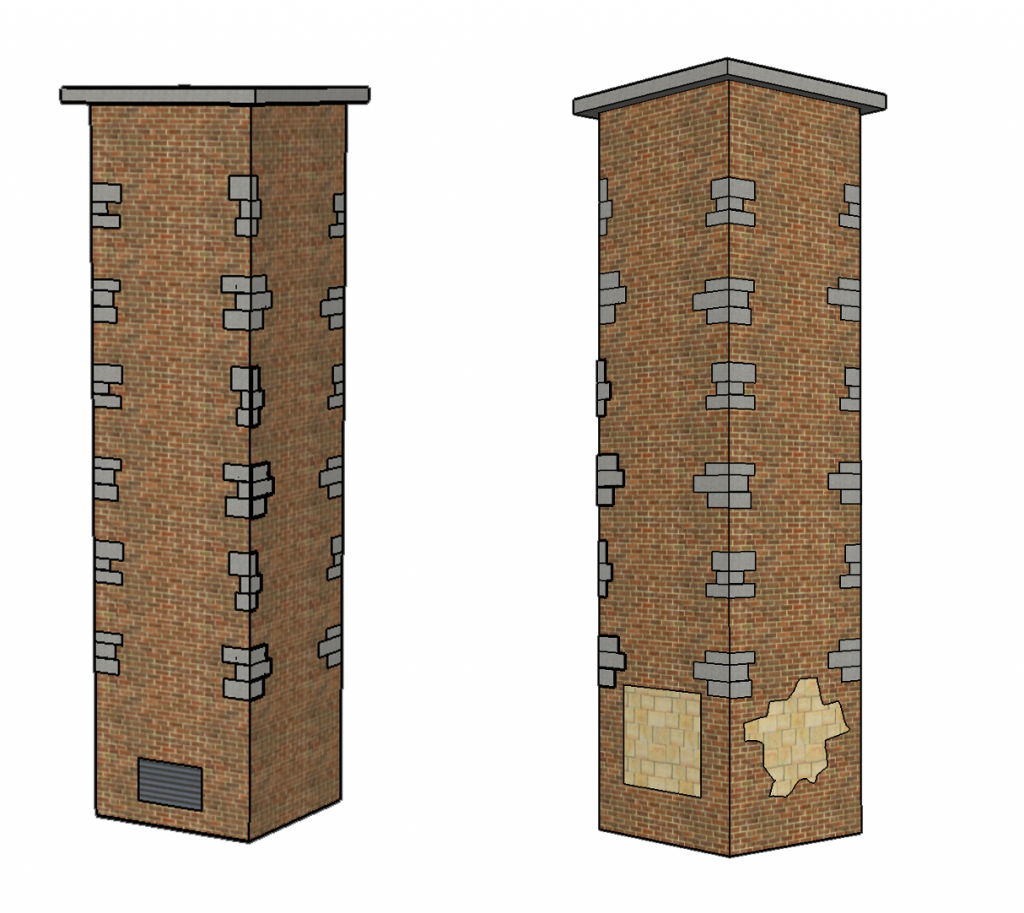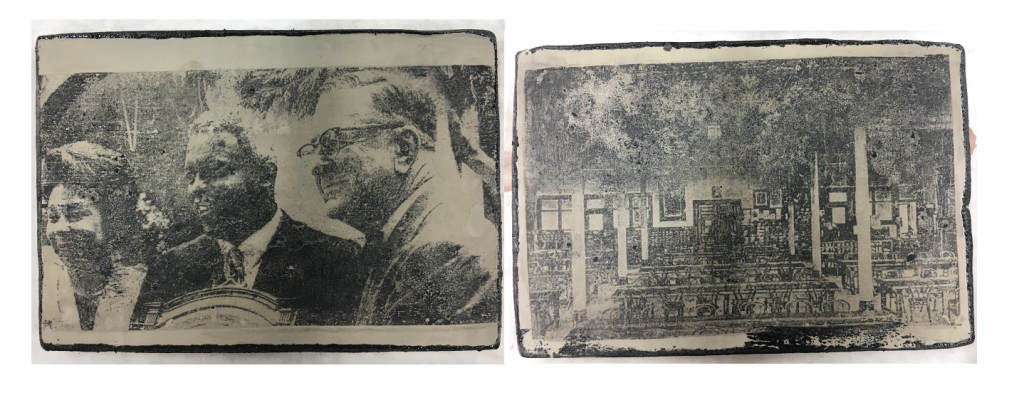OWU has two student-led organizations, affiliated with the Department of Environment and Sustainability. Click on either for more information…
Category: Buildings and Grounds
Rediscovering OWU’s Old Sulphur Spring with ENVS’s Dr. Toshi Mizuta
Spring ENVS Poster Session
Semester projects for GEOG 369 Remote Sensing (Rowley) & ENVS 399 Sustainability Practicum (Krygier). OWU Science Center Atrium, Tuesday May 2, 2023.
ENVS 399 info: GEOG 369 Remote Sensing
Apply for Student Sustainability Coordinator, Fall ’23 and Spring ’24, By April 4
Time for interested students to apply for the Student Sustainability Coordinator position for the Fall of ’23 and Spring of ’24.
Apply on the STAP site, starting Tuesday, March 21.
Applications are due by Tuesday, April 4 at 11:59 p.m.
For the Fall of ’23: A glitch in our application means we don’t have STAP funding for the Fall, but plan to cover the position with ENVS funds. Duties include organizing the Sustainability Task Force meetings (three per semester, noon on Wednesday). Talk to Krygier
Spring ’24: You must apply for the Spring ’24 position, which is 6 hours a week paying $10.75 per hour. Please plan to organize the Sustainability Task Force meetings (three per semester, noon on Wednesday) and attend either or both of the ENVS 399 Sustainability Practicum course meetings (MW 2:10-4pm). Apply on the STAP site, starting Tuesday, March 21.
Details
STAP Internship Title: Student Sustainability Coordinator
Position Description: The Student Sustainability Coordinator position plays a vital role in maintaining and developing sustainability efforts on campus.
The student will organize and lead the campus Sustainability Task Force and liaise with the Environment & Sustainability Department (Anderson, Krygier, Rowley). Students in the position will also work with faculty, staff, and students (including those in Geography 399 & Geography 499) on campus sustainability projects. Typically, the student attends the 0.25 credit ENVS 198/498 Conversations Towards a Sustainable Future course and works with new ENVS students.
Students may engage with additional research projects with ENVS faculty, pursue environmental activism efforts, help manage OWU’s Green Week, May Move Out, and other initiatives. Two students who previously held the position were authors on research papers published in part based on work undertaken while in a STAP position.
Skills/Qualifications Required: Candidates should be organized, enthusiastic, and work well with others (students, staff, faculty). Experience with sustainability efforts on campus helps. Ability to maintain outreach and scheduling while working well without excessive oversight. Ability to use Google Drive apps, Doodle, etc. necessary. But who can’t do that?
Examples of Assignments/Duties: Sustainability Task Force (leadership, organization, content) in collaboration with Anderson, Krygier, Rowley. Assist with organization of May Move Out, Green Week, campus habitat enhancements (Chimney Swift Tower, bird habitats, etc.), recycling issues, food issues, composting, liaise with WCSA, Tree House, Citizens Climate Lobby, regional ROAR collaboration (Otterbein, Denison, Kenyon, etc.), City of Delaware, MTSO, Stratford, Preservation Parks.
Applications: Students interested broadly in the environment and sustainability. Environmental Science, Environmental Studies, Biological and Earth Sciences, P&G, Sociology, Nutrition, Psychology, etc. Future interests in environmental leadership, careers in the environment, graduate school
Unique Responsibilities: This position, as described above, is literal career training in that it requires passion and competence while allowing the student to pursue and develop important, practical skills. In addition, some previous students have used this position to engage in research, publication, and use the experience as a springboard to graduate school. Responsibility, leadership, motivation, and working for the better good of the environment and sustainability on campus and beyond are central to this position.
Green Week, May Move Out, Food Recovery Network … !!!
Green Week 2022 +++
Ohio Wesleyan Student Event to Celebrate Earth Day and Other Eco-Friendly Initiatives
One day – or even one week – isn’t enough time to highlight all of the Earth-friendly initiatives being spearheaded on campus this spring by Ohio Wesleyan University students.
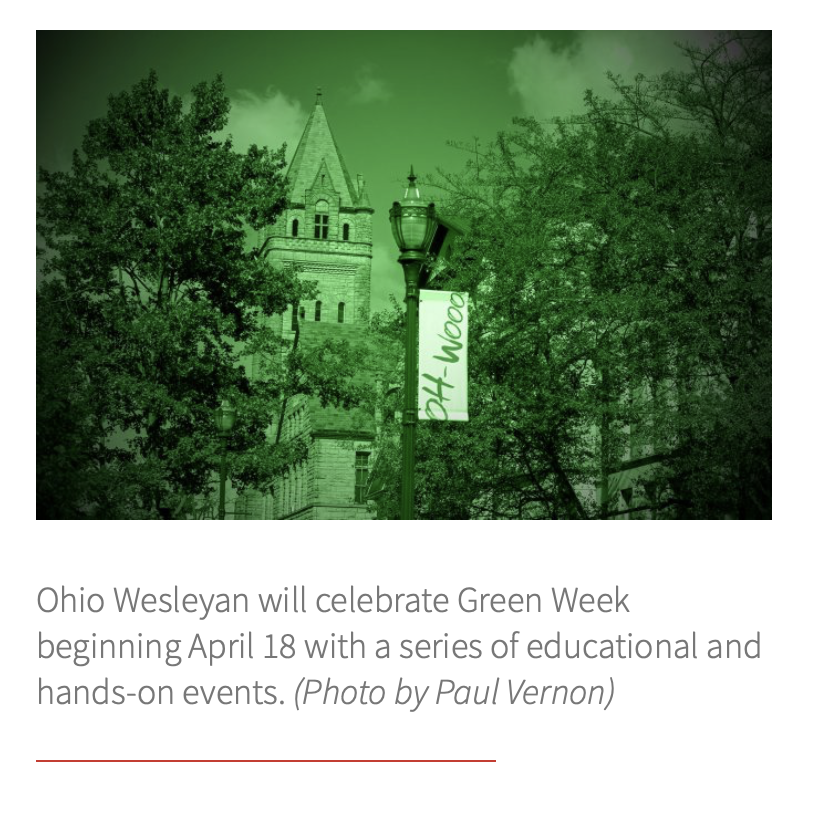 Instead, Environment and Sustainability students, residents of the Tree House small living unit, and others are planning a Green Week that will kick off Monday, April 18, and conclude Tuesday, April 26.
Instead, Environment and Sustainability students, residents of the Tree House small living unit, and others are planning a Green Week that will kick off Monday, April 18, and conclude Tuesday, April 26.
“Yep, Green Week and a half,” said John Krygier, Ph.D., professor of Environment & Sustainability.
A Packed Calendar
Students are planning a calendar of activities that includes information about how to reduce, recycle, and repurpose waste along with lunchtime tabling sessions with long-term environmental partners Del-Co Water Company and the city’s Public Utilities Department to discuss sustainability efforts. Both organizations also will share career and internship information.
The Green Week activities will include an April 23 trash cleanup in collaboration with the Unity Community Center and conclude April 26 with students enrolled in a renewable energy course presenting their research at 10:30 a.m. in the atrium of Schimmel/Conrades Science Center.
Treehouse moderator SK Bulander ’23 of Los Angeles, California, is coordinating this year’s events calendar.
“2040 is the non-negotiable deadline of overhauling our fossil fuel-dependent world before the Earth reaches a global average temperature of 1.5°C and is irreversibly damaged,” said Bulander, an Environmental Science and English (Literature) double major. “In the shadow of such a gargantuan task, it can be terrifying and stressful to even consider the idea of sustainability. My vision for Green Week is that it will give OWU students the tools to make meaningful lifestyle changes that are bite-sized.”
Numerous Opportunities to Get Involved
“Look for activities like ‘Plant-based Problem Solving,’ where students can learn about everyday low-waste and plant-based swaps, and ‘Bee-less Wax Wraps,’ which will instruct on how to make vegan wax wraps as an alternative to plastic wrap, plastic bags, tin foil, plastic lids, and many other single-use items. Make sure to donate old clothes to the pop-up campus trade store and pick up some new, re-used fits,” Bulander continued.
“Meanwhile, Green Week will provide students with a space to analyze the corporate forces driving the climate crisis,” she said. “This includes events like ‘An Introduction to Textiles,’ wherein students will learn about the environmental impacts of the textile industry, and ‘The Root of it: How Community Gardens in the U.S. Combat Food Insecurity,’ at which students can participate in a discussion panel with local community gardens and OWU professors on food insecurity at both the national and local level.
I hope that it will be apparent that there are numerous on-campus and nearby groups pushing for environmental action,” Bulander concluded. “Students looking to get more involved in the environmental side of OWU should join the Sustainability Task Force for monthly meetings that bring together the university’s administrators, faculty, staff, and students for updates on OWU’s environmental movements. It provides a great space for networking for careers in sustainability and acts as an excellent starting point for becoming more involved in clubs. I would also recommend they try out Citizens’ Climate Lobby (CCL) to advocate for local, bipartisan carbon emission-cutting legislation, especially in our extremely divisive political landscape today.”
May Move Out Recycling
On Earth Day (April 22), the group will launch this year’s May Move Out initiative, which urges students to donate usable clothing, books, furniture, household goods, and other items as they clear out their rooms at the end of the semester. Begun in 2012, the decade-old program typically recovers 10 tons of material annually that otherwise would go to a landfill.
Large, temporary storage pods will be set up to collect donations in parking lots at the Chi Phi fraternity on Williams Drive and at the Bradford Milligan, Smith, Stuyvesant, and Welch residence halls. Items will be accepted from 7 a.m. to 7 p.m. during the collection period and then donated to Goodwill. For more information and a list of acceptable items and donation dates, visit maymoveout.owu.edu.
May Move Out coordinator Graham Steed ’23 of Marion, Ohio, said he hopes students take the time to sort and donate all of their recyclables.
“Each item they dispose of has great impact on the well-being of our ecosystem and society,” said Steed, an Environmental Studies major. “Not only does each piece of trash travel great distances to landfills within our country or others, which produces large amounts of CO2, but also once they get there, they pollute the local community from toxic runoff. These communities are most often poor and communities of color, which further adds an intersectional aspect to this issue.”
Recovering Food, Nourishing Others
In addition to Green Week and May Move Out, Ohio Wesleyan students this semester also are relaunching an initiative to share unused dining hall food with the community. Ohio Wesleyan is a member of the national Food Recovery Network.
Students Abby Charlton ’25 of Newark, Ohio, and Savannah Domenech ’25 of Webster, New York, are overseeing this renewed effort, which includes collecting unused food once a week.
Domenech, an Environmental Studies and Geography double major, said of a recent collection, “we got over 30 pounds of food consisting of buffalo chicken, beef brisket, steamed rice, and mixed vegetables. However, in the past, the club has gotten over a hundred pounds of food for one recovery. After we weigh the food, we cart it over to Grace Clinic across the street, and they distribute it to their patients.”
Improving Water Quality
Another initiative restored this semester is the use of a storm net to collect debris from the Delaware Run, which flows through the north side of campus on its way to the Olentangy River. The 13,000-pound, 4-foot-high, 18.5-foot-wide, concrete-weighted storm net structure was installed into the Delaware Run in 2019, prior to the pandemic.
Students Logan Honchul ’24 of Trenton, Ohio, and AJ Lashway ’23 of Niskayuna, New York, began working with the City of Delaware’s Department of Public Utilities this semester to restore the net, monitor it, and analyze the items collected.
“I’m hoping to get more experience in water-quality testing, since my background in that aspect is more limited,” said Lashway, a Zoology, Environmental Science, and Creative Writing triple major. “It’s such an important part of understanding the health of bodies of water, so I’m excited to get better at properly analyzing the collected data. It will also be a great experience to be able potentially make changes based on the information we gather.”
Honchul said she also is interested in learning and honing skills to support her career goal of working in wildlife conservation.
“As a Zoology major, I have a strong passion for animals, and working with them in any capacity excites me,” said Honchul, who is double majoring in Environmental Science and minoring in Communications. “I hope I am able to help improve the local wildlife habitat. I hope to learn about how much litter and debris really affect local water life.”
Learn more about Ohio Wesleyan’s Department of Environment and Sustainability at owu.edu/environment.
Apply Now: Student Sustainability Coordinator: 2022-23 Position
Applications for the Fall 2022 – Spring 2023 Student Sustainability Coordinator position are open.
Applications are due Tuesday, April 5th at 11:59 p.m.
Brief interviews: March 22nd – April 19th.
Decision: Wednesday, April 27th
Questions: Talk to Krygier
Apply here: 2022-2023 On-Campus Internship Student Application
STAP Internship Title: Student Sustainability Coordinator
This position links to ongoing campus-wide efforts to improve sustainability, including a revision of our 2017 Sustainability Plan and a CleanTech U proposal that would substantially affect OWU’s campus and student experience.
Position Description: The Student Sustainability Coordinator position plays a vital role in maintaining and developing sustainability efforts on campus.
The student will organize and lead the campus Sustainability Task Force and liaise with the Environment & Sustainability Department (Anderson, Krygier, Rowley). Students in the position will also work with faculty, staff, and students (including those in Geography 360 & Geography 499) on-campus sustainability projects. Typically, the student attends the 0.25 credit ENVS 100.2/400.1 Conversations Towards a Sustainable Future course and works with new ENVS students.
Students may engage with additional research projects with ENVS faculty, pursue environmental activism efforts, help manage OWU’s Green Week, May Move Out, and other initiatives. Two students who previously held the position were authors on research papers published in part based on work undertaken while in a STAP position. The 2019-20 coordinator was awarded a PhD level graduate fellowship with full funding.
Skills/Qualifications Required: Candidates should be organized, enthusiastic, and work well with other people (students, staff, faculty). Experience with sustainability efforts on campus helps. Ability to maintain outreach and scheduling while working well without excessive oversight. Basic ability to use Google Drive apps, Doodle, etc. necessary. But who can’t do that?
Examples of Assignments/Duties: Sustainability Task Force (leadership, organization, content) in collaboration with Anderson, Krygier, Rowley. Assist with organization of May Move Out, Green Week, campus habitat enhancements (Chimney Swift Tower, bird habitats, etc.), recycling issues, food issues, composting, liaise with WCSA, Tree House, Citizens Climate Lobby, regional ROAR collaboration (Otterbein, Denison, Kenyon, etc.), City of Delaware, MTSO, Stratford, Preservation Parks.
Applications: Students interested broadly in the environment and sustainability. Environmental Science, Environmental Studies, Biological and Earth Sciences, P&G, Sociology, Nutrition, Psychology, etc. Future interests in environmental leadership, careers in the environment, graduate school
Unique Responsibilities: This position, as described above, is literal career training in that it requires passion and competence while allowing the student to pursue and develop important, practical skills. In addition, some previous students have used this position to engage in research, publication, and use the experience as a springboard to graduate school. Responsibility, leadership, motivation, and working for the better good of the environment and sustainability on campus and beyond are central to this position.
Moving Sustainability Forward at OWU: Upcoming Meetings
 Mark your calendars and watch for more information on two upcoming really important meetings regarding sustainability at OWU:
Mark your calendars and watch for more information on two upcoming really important meetings regarding sustainability at OWU:
Thursday, February 10 at 6 pm (Beeghly Library 2nd Floor Bayley Room)
Friday, February 11 at noon (Beeghly Library 2nd Floor Bayley Room)
We are asking for volunteers to help with the first significant update to OWU’s Sustainability Plan since 2017. This is good for OWU and good for participants, who will engage in what is in essence a professional sustainability effort. This group and its efforts are not formally affiliated with or endorsed by the OWU administration but will develop a plan and set of recommendations in line with current sustainability practices, at peer institutions, organizations, and companies.
I will update this blog posting in the near future with more details.
Some background:
It’s been five years since OWU’s first Sustainability Plan – created by students – was adopted by OWU. The plan is, frankly, a bit toothless. It was vetted by students (primarily Emily Howald, ’18) and adjusted to the realities of an institution that was not yet ready to commit to more challenging sustainability goals. Keep in mind this was a time of major fundraising for the very important OWU Connection and also one of increasing enrollment challenges (felt by all colleges, as the number of college-age students declines in the US).
OWU is making progress. For example, the map below (right mouse click to see larger map) documents both existing and proposed sustainability projects on campus. These are largely grassroots projects, most involving students and the OWU Connection.
Move forward to Fall of 2021. Fred Copeman, OWU ’11, is in the graduate program for Sustainability Management at Columbia University. He takes on OWU as a case study, in a course, assessing the means by which OWU can seriously institute sustainability institution-wide.
Spring 2022: Fred will be on campus to move the effort forward on Thursday, February 10, and Friday, February 11. Meetings with students, staff, and faculty are scheduled for Thursday, February 10 at 6 pm (Beeghly Library 2nd Floor Bayley Room) and Friday, February 11 at noon (Beeghly Library 2nd Floor Bayley Room).
Updates coming soon.
Analyzing Recycling at OWU: Spring 2020
Back when Covid-19 was barely a thing, OWU ES major Ash Moen (’20) and Meg Edwards (’22) literally dug into the stuff OWU students toss in the recycling bins in a systematic manner, collecting data that sheds light on recycling successes and failures.
The presentation Ash created includes the data and recommendations. Covid got in the way of implementing recommendations, but now is the time to rekindle this effort. Students interested in taking on recycling on campus in collaboration with Ed Pullen (ABM) should contact John Krygier or Student Sustainability Coordinator AJ Lashaway.
Click on the image below (or here) to navigate to the data and presentation.
OWU Sustainability Task Force Meeting: Sept 27 @ Noon @ Merrick 201
Dr. Krygier in the OWU ENVS Dunk Tank at the Olentangy River Festival (Sept. 2021)
Our first STF Meeting for the Fall of 2021 is Monday, Sept. 27 @ noon in 201 Merrick Hall.
Organizer: AJ Lashaway
Dr. Krygier/AJ→ OWU Outside update (hopefully MTSO reaches out, call Audubon)(make QR code for groupme)
→ Chimney Swift tower
→ Energy Projects: big and small
→ Bioretention Cells
→ any other sustainability things going on on campus
Ed Pullen→ recycling + waste management on campus
Erin Wolfe→ sustainability in Delaware
→ watershed
→ events OWU students can attend/opportunities available to them
SK (Treehouse) → Green Week, house events outside students can attend/help with
And SO much MORE.
OWU Chimney Swift Tower. This Fall! Really!
A very cool project, planned and developed since 2012, is funded and ready to build. It has been delayed over and over, and frikkin’ COVID has slowed it down, but the plan is to start construction before the end of August (2021).
Watch for updates here: but for now, the proposal and details are below.
Proposal: OWU Chimney Swift Tower
Ohio Wesleyan University
Spring 2021
Dick Tuttle (’73), Caitlyn Buzza (’12), Alex Johnson (’15), Ashley Tims (’17), Dustin Reichard (Zoology), John Krygier (E&S, Geography)
Contact: John Krygier (jbkrygier@owu.edu)
Summary
The purpose of the Chimney Swift Tower project is to provide a safe area for resting and nesting of chimney swifts. Chimney swifts consume a significant number of mosquitos and thus reduce student’s exposure to mosquito-borne illnesses. The tower will also serve as an important point of interest on the residential side of campus, an attraction for both prospective students and those already on campus. As a student-driven project in collaboration with OWU alumni, the tower serves as a notable example of theory-into-practice and the OWU Connection.
Chimney swifts evolved to live in dead, hollow, tree trunks and adapted to chimneys over time. Chimneys are increasingly rare in new buildings and often closed off in older buildings. Thus humans created a habitat for these birds, and are now removing that human-constructed habitat. In response to this problem, artificial chimney swift towers have been constructed over the last few decades. OWU Alumni Dick Tuttle has spent years documenting the many chimney swifts in Delaware, and his experience suggests that a swift tower on OWU’s campus, near Stuyvesant Hall, would be a prime location for the birds. We have visited the site with Peter Schantz who sees no practical problems with the proposed location. Tuttle has tentatively agreed to fund the construction of the tower with a gift to OWU. The typical tower, about 5’ x 5’ and 20’ to 30’ tall, can accommodate around 100 birds. The swift tower will attract student attention: swifts entering the tower at dusk are an impressive sight. For students (and prospective students) pursuing biology, environmental science, and environmental studies the towers will be of much interest. Importantly, for the typical student (or prospective student) the towers will be an intriguing addition to OWU’s campus, signaling OWU’s commitment to the environment while promoting interest in the natural world. The tower, which will have information about chimney swifts and the function of the tower, will serve as an important point of interest on the residential side of campus.
Key Components
Planning for the tower is and will continue to be a collaboration between students, faculty, and alumni. Plans have been developed over several years by students (Caitlyn Buzza ’12, Alex Johnson ’16, and Ashley Tims ’17) working in collaboration with OWU Alumni Dick Tuttle (’73) and faculty members Dustin Reichard (Zoology, ornithology), John Krygier (Geography & Environmental Studies, sustainability), and Kristina Bogdanov (Art, ceramics). Tuttle, Reichard, Bogdanov, and Krygier will work with mason John Kuhn on design details and construction of the tower.
1. The tower will meet the standards set by Paul D. Kyle in his book Chimney Swift Towers: New Habitat for America’s Mysterious Birds, A Construction Guide (Texas A&M University Press, 2005). These guidelines have been used for many successful towers. John Kuhn, our contractor, is an experienced mason who has also taught masonry courses. He should be able to integrate OWU students in the building project if appropriate.
2. Chimney swifts are of immense value to their immediate environment: they are disinterested in humans and are neither aggressive nor dangerous. They consume an immense amount of flying insects, including mosquitos. Thus they serve an important public health role. A functioning chimney swift tower will significantly reduce the number of mosquitos on campus (as they will most likely fly back and forth from the tower to the Olentangy River).
3. The tower will be located to the north-east of Stuyvesant Hall, near the top of the hill that slopes down to William St. This is a good location for the chimney swifts (high, open) but also for observing birds from the residential halls, the newly renovated terrace in front of Stuyvesant Hall, and William St. Peter Schantz has recommended this location. (see below)
Map of location for proposed chimney swift tower.
4. The tower will serve specific courses on campus, and associated faculty and students. In particular, Dr. Dustin Reichard and his ZOOL 341: Ornithology course. See Dr. Reichard’s letter of support. (See Appendix 1).
5. The tower project is representative of student theory-into-practice projects on and around campus, focused on environment and sustainability. For prospective students, the project provides a tangible example of theory-into-practice and campus/community collaboration. The tower project serves as an example of and inspiration for the kind of projects students in the Environment and Sustainability Program (Environmental Studies and Environmental Science) have undertaken in courses such as John Krygier’s GEOG 360: Environmental Geography and GEOG 499: Sustainability Practicum, as well as independent studies and SIP funded projects.
6. The tower will be attractive, fitting into the aesthetic of OWU’s campus while serving as a landmark and destination for students (and prospective students). The preliminary proposal includes brick construction with stone accents using recycled bricks and stone from campus, to match the materials used in Stuyvesant Hall. (see below)
Draft design of proposed chimney swift tower (access hatch, left, tile inserts, right)
7. The tower will also be tastefully distinctive, with Ohio Wesleyan-themed ceramic artwork near the base. Dr. Kristina Bogdanov (Art, ceramics) has agreed to assist with removable (or permanent) panels at the base of the tower. The primary medium will be tiles, created from recycled clay and dyes. Building on a project started by former OWU biology and art major Ashley Tims (’17), Bogdanov and students will create tiles with permanent images, such as historical OWU photographs (see below). In addition, tiles will be created that depict the leaves of local, native trees and plants, common birds and animals, insects, bees, and other natural features of the campus area. These OWU inspired tiles can be changed out or added to over time. The tiles can be used in activities by admissions (with prospective students) as well as part of orientation for new students, as a way of relating the history and environment of our campus. We also propose a mosaic tile description of the tower, chimney swifts, and illustrations of how the towers work. Thus un-guided visitors can learn what the tower is about and how it works.
Photograph transfer tiles for base of proposed chimney swift tower.
Appendix 1: Letter of faculty support from Dr. Dustin Reichard (Zoology) & Dr. John Krygier (Geology & Geography, Environment & Sustainability)
To: OWU University Advancement & Administration
From: Dustin Reichard (Zoology), John Krygier (ENVS, Geography)
Re: Chimney Swift Tower on OWU Campus
We are writing to convey our strong support for the installation of a chimney swift tower on the OWU campus. Chimney swifts are migratory songbirds that spend their summers breeding in eastern North America and their winters in western South America. Over the past few decades, chimney swifts have been experiencing a steady decline in population size. A major cause of their decline has been the loss of nesting and roosting habitat as homeowners have transitioned away from brick chimneys and either capped or removed chimneys that are no longer in use. The installation of chimney swift towers is one method for mitigating this decline. Delaware is the summer home of a sizable population of breeding chimney swifts that have been monitored for many years by Dick Tuttle, a committed conservationist from the local community that has offered a generous gift in support of this project.
The addition of a chimney swift tower to the OWU campus will provide numerous benefits to the campus community with relatively limited investment from OWU faculty and staff. From a pedagogical perspective, the tower will provide ample opportunities for students to collect and analyze data of swift roosting, migration, and breeding biology. These opportunities will be utilized by students in Ornithology (ZOOL 341), which is taught every spring, and Organisms and Their Environment (BIOL 122), which is taught every semester. Many of our zoology students are interested in careers related to conservation, and the accessibility of a swift tower on campus would allow them to develop skills in population monitoring while working with an at-risk species.
Additionally, chimney swifts are aerial insectivores that will contribute to the management of aerial insects, such as mosquitoes, which are a nuisance and can carry disease. This issue is particularly relevant given the recent expansion of the Zika virus to the southern United States, and the increased likelihood of more tropical parasites in the future as a result of climate change. The swifts also undertake a tremendous migration to the tropics each winter, which makes the bird an excellent international ambassador as OWU seeks to attract a larger number of international students. Finally, observing the birds enter the tower each evening to roost is an amazing natural spectacle that will undoubtedly thrill members of the community for years to come.
This proposal for chimney swift towers grew out of efforts to enhance habitats for birds, insects, and animals on and around the OWU campus. Work on this project over the past year or two has entailed determining viable locations for the tower, generating plans and designs, all done in consultation with Buildings and Grounds (for advice and input). Additional related campus projects include birdhouses, bat houses, and bee hotels. The development of such habitats on campus is one component of our proposed campus sustainability plan.
Please contact us with any additional questions, and let us know how we can proceed on this important opportunity.
Dustin Reichard
John Krygier
